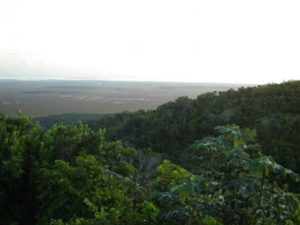 CUBA DESCONOCIDA: LOMA DE CUNAGUA, CIEGO DE AVILA, UN LABORATORIO DE LA NATURALEZA.
CUBA DESCONOCIDA: LOMA DE CUNAGUA, CIEGO DE AVILA, UN LABORATORIO DE LA NATURALEZA.
La zona, ubicada en el municipio de Bolivia en la provincia cubana de Ciego de Ávila, en la cayería norte de esa central provincia, ubicada a 430 kilómetros al este de La Habana, es considerada una de las mayores alturas de la provincia avileña con 364 metros sobre el nivel del mar, el sitio sobresale por su biodiversidad y panoramas naturales que resguarda a un grupo de especies endémicas, vulnerables y amenazadas.
Cunagua es una palabra aborigen que significa flor de agua y fue, además, el nombre del cacique de una tribu indígena que vivió en ese punto de la geografía cubana.
Perteneciente al Gran Humedal del Norte de Ciego de Ávila, la Loma de Cunagua, sirve de refugio a aves silvestres como el tocororo (ave nacional de Cuba), cartacuba, cotorras, cateyes, el zorzal real y los carpinteros verde y jabao.
Este lugar distinguido por la presencia de especies endémicas, raras, vulnerables y amenazadas, como las cotorras y cateyes, está rodeado por el Gran Humedal del Norte de Ciego de Ávila, ubicado tanto al sur como al norte de sus elevaciones.
En el sitio se encuentra una buena representación de reptiles y habitan aves como el tocororo, cartacuba, zorzal real, carpinteros verde y jabao.
Se reportan, además, 83 familias de plantas superiores con 265 géneros y más de 300 especies aproximadamente, de las cuales un por ciento elevado son oriundas de la región y en ellas viven otros plumíferos terrestres como el boyero, el barbiquejo y la paloma perdiz, esta última también con peligro de desaparecer.
Cuenta, además, con una rica diversidad florística, formada por más de 900 variedades, entre las que destacan las melíferas, poliníferas, medicinales, ornamentales, maderables y las que pueden utilizarse en la alimentación humana y animal, y en la artesanía o la industria.
Asimismo hay presencia de plumíferos terrestres como el boyero, barbiquejo, guanaro y la paloma perdiz, ave de los campos cubanos que por estar en fase de extinción, está sometida a un programa de preservación.
En la zona también habitan una gran variedad de reptiles, 83 familias de plantas superiores de 265 géneros y más de 300 especies, la mayoría oriundas de la región.
Cunagua, es catalogado como un laboratorio natural de relevancia en el centro de Cuba.
 UNKNOWN CUBA: LOMA DE CUNAGUA, CIEGO DE AVILA, A NATURAL LABORATORY.
UNKNOWN CUBA: LOMA DE CUNAGUA, CIEGO DE AVILA, A NATURAL LABORATORY.
The area, located in the municipality of Bolivia in the Cuban province of Ciego de Ávila, in the northern part of that central province, located 430 kilometers east of Havana, is considered one of the highest heights of the Avilanian province with 364 meters above sea level, the site stands out for its biodiversity and natural panoramas that protects a group of endemic, vulnerable and threatened species.
Cunagua is an aboriginal word that means water flower and was, in addition, the name of the chief of an indigenous tribe that lived in that point of the Cuban geography.
Belonging to the Great Wetland of the North of Ciego de Ávila, the Loma de Cunagua, serves as a refuge for wild birds such as tocororo (national bird of Cuba), Cartacuba, parrots, cateyes, the royal thrush, and the green and jabao carpenters.
This place distinguished by the presence of endemic, rare, vulnerable and threatened species, such as parrots and cateyes, is surrounded by the Great Wetland of the North of Ciego de Ávila, located both south and north of its elevations.
On the site, there is a good representation of reptiles and birds such as tocororo, cartacuba, royal thrush, green carpenters and jabao.
In addition, 83 families of higher plants with 265 genera and more than approximately 300 species are reported, of which a high percentage are from the region and they live in other land feathers such as the buoy, the chinstrap and the partridge dove, The latter is also in danger of disappearing.
It also has a rich floristic diversity, consisting of more than 900 varieties, among which are the honey, polyniferous, medicinal, ornamental, timber and those that can be used in human and animal food, and in handicrafts or industry.
There is also the presence of terrestrial feathers such as the buoy, chinstrap, guanaro and the partridge pigeon, a bird from the Cuban fields that, due to its extinction phase, is subject to a preservation program.
In the area, there is also a great variety of reptiles, 83 families of higher plants of 265 genera and more than 300 species, most of them from the region.
Cunagua, is listed as a natural laboratory of relevance in the center of Cuba.
Agencies/ RHC/ Lubia Ulloa/ Internet Photos/ Maydenys Rodriguez/ Arnoldo Varona/ www.TheCubanHistory.com
THE CUBAN HISTORY, HOLLYWOOD.









